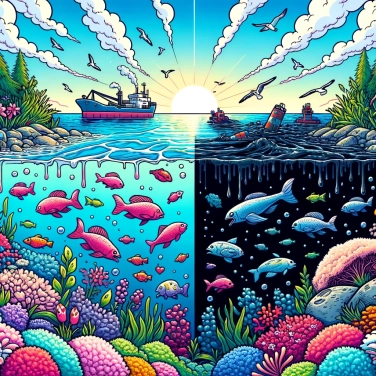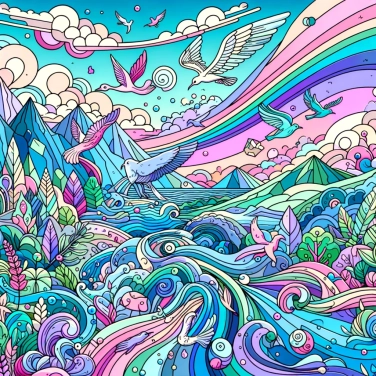Oil spills are harmful to marine ecosystems as they can lead to the death of many marine species, contaminate their habitat, disrupt food chains, and have long-term effects on biodiversity and ecosystem productivity.

Oil spills have a devastating impact on marine fauna. When an oil spill occurs, hydrocarbons spread into the ocean, sticking to the feathers of seabirds, the shells of sea turtles, and the fins of marine mammals. These oil substances can cause chemical burns, respiratory problems, skin lesions, and hormonal disruptions in marine animals. Species that come into direct contact with the oil are at risk of experiencing a significant increase in mortality rates.
Oil spills cause the destruction of marine habitats, particularly sensitive coastal areas such as salt marshes, estuaries, mangroves, and coral reefs. These ecosystems harbor a great diversity of species and provide essential areas for reproduction, feeding, and protection of juveniles. When affected by an oil spill, these habitats become contaminated by toxic hydrocarbons present in the oil.
The presence of oil on beaches and in wetlands can lead to the suffocation of living organisms by forming a dense layer that blocks gas exchange. Hydrocarbons can also penetrate the soil, contaminating the roots of plants and affecting their growth and survival. Herbivores and predators that rely on these habitats for food are also affected, as their food source is poisoned or destroyed.
The destruction of habitats caused by oil spills can have long-term effects on marine ecosystems, disrupting food chains and leading to a decline in biodiversity. It is essential to understand the extent of damage to coastal habitats to assess the overall impact of oil spills on marine ecosystems and implement appropriate conservation measures to promote their recovery.
In the event of an oil spill, hydrocarbons spread in the marine environment, generating serious chemical contamination. These petroleum substances contain toxic compounds such as polycyclic aromatic hydrocarbons (PAHs) and aliphatic hydrocarbons. These chemicals can have long-term detrimental effects on living organisms.
When they come into contact with marine organisms, hydrocarbons can cause internal injuries, alter their respiratory system, disrupt their immune system, and cause reproductive problems. The most vulnerable organisms are eggs, larvae, juveniles, and adult animals during the breeding period.
Chemical contamination related to oil spills can also lead to effects at higher trophic levels. Toxic substances can accumulate in the tissues of predators, increasing the concentration of pollutants as they move up the food chain.
Finally, some chemical compounds present in hydrocarbons can persist in the marine environment for many years, prolonging the detrimental effects of oil spills on marine ecosystems.
Oil spills have a devastating impact on the food chain of marine ecosystems. Indeed, hydrocarbons present in oil have the ability to attach to the tissues of marine organisms. Species at the bottom of the food chain, such as phytoplankton and zooplankton, absorb these chemicals. As a result, these organisms are contaminated and toxins can concentrate at dangerous levels in their bodies.
Organisms at a higher trophic level, such as fish and marine predators, feed on the contaminated organisms. Thus, toxins accumulate at each stage of the food chain, a process known as bioaccumulation. This means that top predators, such as tuna, dolphins, or even humans consuming seafood, can ingest dangerous amounts of toxins from the oil spill.
Bioamplification is a phenomenon related to bioaccumulation, where toxins become even more concentrated at each trophic level of the food chain. Thus, top predators in the chain, such as large marine predators, are most affected by this cumulative contamination.
The impact on the food chain can have dramatic consequences for marine ecosystems, including disrupting the ecological balance and threatening the survival of certain species. The effects of an oil spill on the marine food chain can be felt for many years, even decades, after the initial cleaning of the oil.
According to a scientific study, the negative effects of oil spills can persist in certain marine ecosystems for several decades after the disaster.
The feathers of seabirds lose their thermal insulation when they come into contact with oil, exposing these birds to hypothermia and an increased risk of drowning.
Several bacteria naturally present in the oceans are capable of degrading a portion of the oil spilled during oil spills, but this natural process can take years or even decades, depending on the local environmental conditions.
The main economic impact of an oil spill is often related to fishing and tourism. Water and coastal contamination can lead to the closure of fishing areas, significantly reduce tourist influx, and cause profound and lasting economic losses for local communities that depend on these activities.
The most vulnerable species are often those found at the surface or near the coasts. This includes seabirds, marine mammals, fish that live close to the surface, and many coastal organisms such as crustaceans and mollusks.
Several methods exist to reduce the impact of an oil spill: floating barriers, chemical dispersants, mechanical recovery, and bioremediation. No single solution is 100% effective, but often a combination of several strategies is employed to maximize efficiency.
Yes, oil can degrade naturally due to climatic conditions and the action of microorganisms; this is referred to as biodegradation. However, this natural process can be very slow, especially for heavy compounds or in cold or low-oxygen environments.
The complete recovery of a marine ecosystem after an oil spill can take years or even decades. The speed of recovery depends on multiple factors, such as the amount of oil spilled, the type of oil, local environmental characteristics, and the effectiveness of cleanup efforts.

No one has answered this quiz yet, be the first!' :-)
Question 1/5